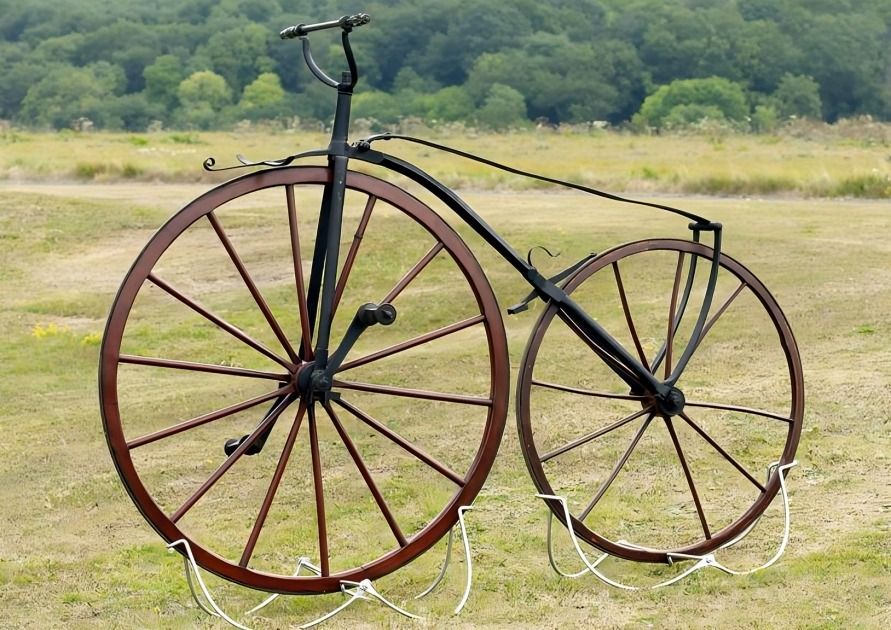
“
Discover Interesting Bicycle Facts that will ignite your curiosity! Bicycles have evolved significantly since the days of the “boneshaker,” a basic ride that rattled more than just your bones. Explore their fascinating journey and innovations! Discover the journey from France’s early designs to the sleek, modern bikes of today, including groundbreaking innovations like the “safety bike” that made cycling safer and more accessible. Whether you're an avid cyclist or just intrigued by 2-wheeled marvels, these fascinating facts will not only astonish you but also deepen your appreciation for the incredible history and impact of bicycles. Get ready to pedal through these captivating insights!1
1
”
The very first bicycles were crafted in France, marking the beginning of bicycle history. However, the sleek and efficient design we use today was perfected in England, showcasing the evolution from early models to modern innovations in bicycle technology. 1

The inaugural commercial bicycle, known as the “Boneshaker,” was introduced in Paris in 1868. Lacking springs and weighing a hefty 80 kg, it provided a bone-rattling ride, highlighting the early challenges in bicycle comfort and design.
Hold on tight! The record for the longest bicycle, stretching an incredible 55.16 meters, was set by a team from the Netherlands in April 2024. Their efforts reflect a passion for Guinness World Records and achieving extraordinary feats. 2

In Moscow, 2,620 people gathered on July 13, 2019, to create the world’s largest human image of a bicycle. This remarkable event demonstrated the unity and enthusiasm of cycling enthusiasts from around the globe.
Cycling is a health hero! It significantly lowers the risk of heart disease and stroke, making it an excellent choice for those seeking a fun and effective way to stay fit and maintain a healthy lifestyle. 3
Imagine riding a bike that reaches a towering height of 7.77 meters! This impressive achievement was accomplished in Clermont-Ferrand, France, in May 2022. It highlights the remarkable creativity and engineering skills within the cycling community. 4
Bicycles are planet savers! They help conserve over 238 million gallons of gasoline annually, contributing significantly to reducing our carbon footprint and promoting environmental sustainability. 5
The Tour de France, the most prestigious bicycle race, has been challenging riders since 1903. This iconic three-week event concludes in Paris and is renowned worldwide for its intense competition and historical significance. 6
Cycling can make you feel up to 10 years younger! Research from England shows that regular cyclists enjoy a two-year increase in life expectancy compared to those who do not cycle, demonstrating its remarkable health benefits. 7
Riding a bike at speeds of 10-15 mph requires about the same energy as walking. Air drag affects energy use, with higher drag increasing effort. Cyclists can reduce drag and energy use by maintaining a compact, aerodynamic position close to the seat. 8
Wooden bikes were once a popular mode of transportation. Crafted from timber, these early bicycles featured wooden frames and wheels, showcasing the ingenuity of their creators. Although they have largely been replaced by metal bikes, they remain a fascinating piece of history. 9
The record for the longest journey by bicycle within a single country exceeds 75,000 miles (120,000 km). This remarkable achievement highlights extraordinary endurance and adventure, showcasing the determination and resilience required for such an epic cycling feat. 10
In 2022, Filippo Ganna set a new record by cycling 56.792 kilometers in one hour at the Velodrome Suisse. This impressive performance surpassed previous records and demonstrated the remarkable limits of human endurance and athletic ability in the realm of competitive cycling. 11
The most expensive bike ever sold, Damien Hirst's Trek Madone, also known as the Butterfly Bike, was auctioned for a staggering $500,000 at Sotheby's. Its high price reflects its unique artistry and collectible value. 12
A bicycle can stay upright without a rider if it’s traveling at 8 mph or faster. This fascinating phenomenon results from the interplay of balance and momentum, demonstrating how speed affects the stability and self-correcting nature of a bike. 13
Orville and Wilbur Wright, pioneers of the first successful airplane, ran a small bike repair shop in Dayton, Ohio. They used their workshop to construct the 1903 Wright Flyer, demonstrating how their bicycle expertise contributed to aviation history. 14
Bicycles were introduced to China in the late 1800s. Today, more than half a billion bicycles are in use across the country, highlighting their enduring popularity and the significant role they play in China's transportation landscape. 15

The Penny Farthing, featuring a large front wheel and a small rear wheel, represents one of the earliest bicycle designs. This unique configuration reflects an intriguing period in cycling history, showcasing early innovation and the evolution of bike technology.
The average lifespan of a bicycle can vary depending on usage, maintenance, and the quality of the bike. Generally, a well-maintained bicycle can last between 10 to 20 years. Regular servicing and proper care can extend its lifespan even further. 16
Modern bikes can be equipped with smart bike computers that track metrics such as speed, distance, heart rate, and GPS location. These devices often sync with smartphone apps for detailed analysis and route planning. 17


